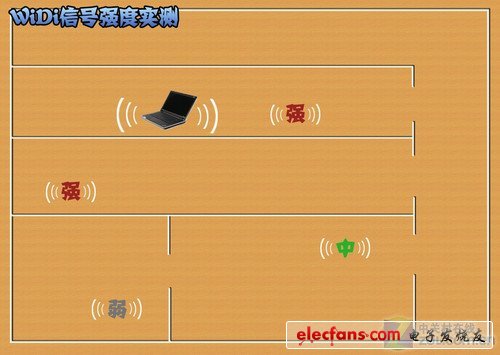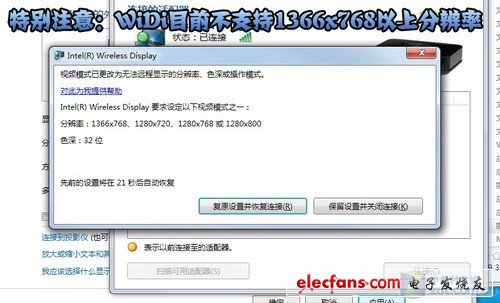Connect both ends of the HDMI cable to NETGEAR Push2TV and an external TV, turn on the power, adjust to HDMI input mode in the TV menu, and the relevant software configuration screen will pop up. At this time, the indicator light of the Push2TV adapter turns red, and the TV screen prompts Ready for connection, waiting for the laptop to connect to the adapter.

Waiting to connect to wireless device

Smooth playback of HD video test
After connecting to the adapter, the external monitor immediately shows the contents on the laptop. We selected a 1080P high-definition video file for transmission test and projected the laptop onto the external screen. The entire playback display was smooth without pauses. At the same time, it can also output audio signals, and the sound is synchronized with the playback screen without stagnation.


WiDi signal strength test
Since WiDi technology relies on wireless network transmission, if we place laptops in different locations in the office for connection, will the penetration ability of wireless signals affect the display effect of the TV? With doubts, we tested the signal strength of WiDi. The 4 simulated test points are shown in the figure above. After testing, we compared the signal strength of the 4 points and found that it is the same as the transmission principle of ordinary wireless routers. The signal is strongest within the range of straight-line transmission without any obstruction, and the signal strength will weaken as the distance becomes farther or there is an obstruction in the middle. After actual testing, the wireless display is normal within a radius of 6M, and the display is interrupted beyond this range.
Summary and Analysis
We connected the laptop to an external TV wirelessly, keeping the distance from the TV about 2 meters. The wireless signal was relatively strong. At this time, we ran a fighting game with high action picture requirements. As a result, a tragedy occurred. The content normally displayed on the laptop would lag behind the picture on the external TV by 1.5 seconds. Since the wireless transmission distance is very short, the influence of network signal strength can be ruled out. This also shows us that the young WiDi technology still exposes its immaturity.

There will be delays when playing games and performing complex operations

We found that whether browsing the web, playing games or playing videos, the pictures will be out of sync. For game enthusiasts and users with high requirements for high-definition video display, WiDi technology is not currently the best solution. In business office applications, although WiDi technology has delays, it does not affect the playback of PPT presentations. After being equipped with such a WiDi device, it can be connected to the projector without any connection, and it also avoids the compatibility problem of the connection between the laptop and the projector.

Resolutions above 1366×768 are not currently supported

Advantages and Disadvantages Analysis
Intel's WiDi technology has indeed brought us a new wireless experience, and its advantages are also obvious: the display content of the notebook can be wirelessly transmitted to the TV and large-size monitor without any connection, and it also supports audio transmission, and no additional equipment is required on the notebook side. Disadvantages: The signal delay is relatively serious, the picture cannot be output synchronously, and it does not support full HD resolution, which affects the user's viewing experience. At present, there are not many wireless network cards that support WiDi technology, which also excludes many users' notebooks. The price of adapters that support WiDi technology is not easy for ordinary consumers to accept.
WiDi technology is still in the popularization stage. Although the threshold for implementation is high and the current price is relatively expensive, we still have reason to believe that through the continuous updating of technology, these problems should not be insurmountable. This technology has more development prospects in business office. If it can get the support of more projector and network manufacturers in the future, I believe that wireless display technology will bring more convenience to everyone.
Previous article:Wireless video transmission: Intel Widi technology revealed (Part 1)
Next article:iPhone 5 leak: NFC chip installed to enable mobile payments
Recommended ReadingLatest update time:2024-11-23 10:25



- Popular Resources
- Popular amplifiers
-
 Microcomputer Principles and Interface Technology 3rd Edition (Zhou Mingde, Zhang Xiaoxia, Lan Fangpeng)
Microcomputer Principles and Interface Technology 3rd Edition (Zhou Mingde, Zhang Xiaoxia, Lan Fangpeng) -
 Microcomputer Principles and Interface Technology Examples and Exercises (Kong Qingyun, Qin Xiaohong)
Microcomputer Principles and Interface Technology Examples and Exercises (Kong Qingyun, Qin Xiaohong) -
 Design and application of autonomous driving system (Yu Guizhen, Zhou Bin, Wang Yang, Zhou Yiwei)
Design and application of autonomous driving system (Yu Guizhen, Zhou Bin, Wang Yang, Zhou Yiwei) -
 x86 Assembly Language: From Real Mode to Protected Mode (2nd Edition)
x86 Assembly Language: From Real Mode to Protected Mode (2nd Edition)
- USB Type-C® and USB Power Delivery: Designed for extended power range and battery-powered systems
- ROHM develops the second generation of MUS-IC™ series audio DAC chips suitable for high-resolution audio playback
- ADALM2000 Experiment: Transformer-Coupled Amplifier
- High signal-to-noise ratio MEMS microphone drives artificial intelligence interaction
- Advantages of using a differential-to-single-ended RF amplifier in a transmit signal chain design
- ON Semiconductor CEO Appears at Munich Electronica Show and Launches Treo Platform
- ON Semiconductor Launches Industry-Leading Analog and Mixed-Signal Platform
- Analog Devices ADAQ7767-1 μModule DAQ Solution for Rapid Development of Precision Data Acquisition Systems Now Available at Mouser
- Domestic high-precision, high-speed ADC chips are on the rise
- Intel promotes AI with multi-dimensional efforts in technology, application, and ecology
- ChinaJoy Qualcomm Snapdragon Theme Pavilion takes you to experience the new changes in digital entertainment in the 5G era
- Infineon's latest generation IGBT technology platform enables precise control of speed and position
- Two test methods for LED lighting life
- Don't Let Lightning Induced Surges Scare You
- Application of brushless motor controller ML4425/4426
- Easy identification of LED power supply quality
- World's first integrated photovoltaic solar system completed in Israel
- Sliding window mean filter for avr microcontroller AD conversion
- What does call mean in the detailed explanation of ABB robot programming instructions?
- STMicroelectronics discloses its 2027-2028 financial model and path to achieve its 2030 goals
- 2024 China Automotive Charging and Battery Swapping Ecosystem Conference held in Taiyuan
- State-owned enterprises team up to invest in solid-state battery giant
- The evolution of electronic and electrical architecture is accelerating
- The first! National Automotive Chip Quality Inspection Center established
- BYD releases self-developed automotive chip using 4nm process, with a running score of up to 1.15 million
- GEODNET launches GEO-PULSE, a car GPS navigation device
- Should Chinese car companies develop their own high-computing chips?
- Infineon and Siemens combine embedded automotive software platform with microcontrollers to provide the necessary functions for next-generation SDVs
- Continental launches invisible biometric sensor display to monitor passengers' vital signs
- Communication Post
- Where is the gap?
- A very good embedded graphical user interface software bitpim
- Network Camera Data/Port Forwarding Hardware Design Solution
- [Comic] Confession of a PCB layout engineer!
- How to distinguish between pads and vias_Differences between vias and pads
- IC manufacturers are ready to conquer the analog arena
- Input protection design and fast acquisition issues of 0-10V input ADC circuit based on TI ADS1115
- Embedded software development job openings
- [Experience] How to replace GigaDevice GD32 and STM32? Differences and precautions

 Microcomputer Principles and Interface Technology 3rd Edition (Zhou Mingde, Zhang Xiaoxia, Lan Fangpeng)
Microcomputer Principles and Interface Technology 3rd Edition (Zhou Mingde, Zhang Xiaoxia, Lan Fangpeng)
















 京公网安备 11010802033920号
京公网安备 11010802033920号